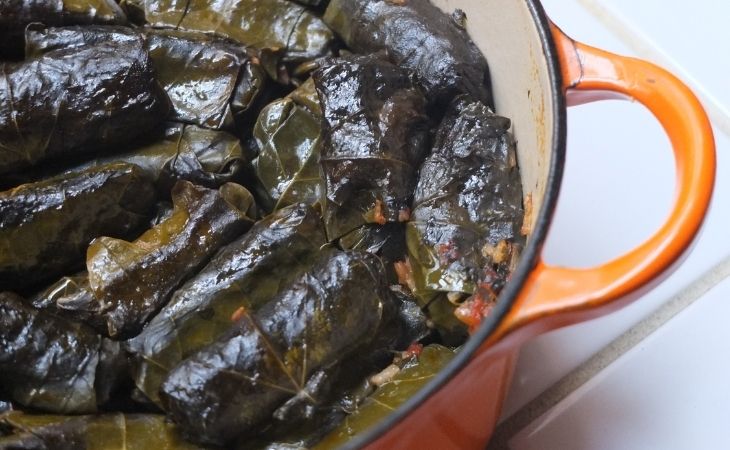Delicious Yalanji
- Middle Eastern Recipes Vegetarian
ThePetiteCheffe
- 11 April 2021
- 0
- 3007

I have been saving this favorite recipe for a special occasion. With spring finally upon us and the preparation for the byzantine / middle eastern Easter festivities, this vegan dish is perfect for lent season. Filled with fresh Tomatoes, loaded with Parsley, seasoned with olive oil and pomegranate molasses, and a good dose of patience, my Yalanji recipe is a sure crowd pleaser.
Mostly enjoyed as a cold appetizer, the origins of this recipe are disputed, as it is commonly prepared in most of the Levant region. However, as is the case with most Middle Eastern dishes, each recipe varies depending not only on the specific country or region but also on which family is preparing it!
What we do know for a fact though, is that the Yalanji is a Turkish word that means “Liar”, the lie being that the stuffing does not contain meat as the mainstream version of stuffed vine leaves does.
Enjoy my illustrated video below, beautifully accompanied by an original composition by my talented friend Yousef Zayed. The best music to best describe the colours, spices and flavours of Home.
And as we say in Arabic, Sahtein صحتين *
*Bon appétit
Ingredients
- 1 jar of vine leaves in brine (around 680ml)
- 1 cup Egyptian rice
- 2 large bunches of flat leaf parsley
- 3 large tomatoes + 1 for the pot
- 2 onions
- 1 small bunch of fresh mint
- 1-2 red chili peppers
- Juice of 2 lemons
- 1/4 cup olive oil
- Salt & pepper
- 2 tbs pomegranate molasses
How to Make It
Step 1
The day before:
Wash and chop the parsley bunches very finely
Wash and chop 3 tomatoes into small cubes
Peel and chop the onions into small cubes
Wash and chop the mint
Wash and chop the chili pepper (use only one right now, you will decide tomorrow if you need to add another chili)
*Note that the hot part of the chili pepper is found in the seeds, so if you do not want it to be too hot, simply omit the seeds
Step 2
Add all the above ingredients into a large bowl then add the juice of 2 lemons, the olive oil, season with some salt and pepper and finally add 2 tablespoons of pomegranate molasses. Mix together and set aside in the fridge for the next day
Step 3
On the day:
Remove the vine leaves from the jar, place the into a large bowl and pour bowling water onto them, let them soak for a few minutes then remove them from the water and place them into a sieve to drain
Step 4
Add the rice to a large bowl, add water and set aside for 1 hour
Step 5
One hour later, add the strained rice to the tabbouleh mix, taste the seasoning and amend if necessary. If you need to add the 2nd chili, now’s the time
Step 6
Strain the tabbouleh mix and preserve the sauce for later
Step 7
Now onto rolling the vine leaves:
Place one one vine leaf on a clean surface, rough side facing you, put a teaspoon of rice stuffing on the lower part of the vine leaf, towards the stem, then fold the bottom edge up to just cover the stuffing. Bring in both sides towards the centre and roll upwards.
Repeat until you have no vine leaves left
Step 8
Onto cooking:
Slice the 4th tomato into medium thin slices, arrange them over the bottom of a pot. This will protect the vine leaves from burning as they cook.
Step 9
Arrange the stuffed vines in circles, making sure they are tightly compressed next to one another, to ensure they do not move during cooking
Step 10
Finally pour over the stuffing juice which you have preserved earlier, for this recipe I used 2 cups of the juice. The rest I froze for later use
Step 11
Cover the pot and bring to a boil. After than reduce the heat to low and leave to simmer for about 2 hours
Once the dish is done, uncover the pot and set aside to cool. I personally enjoy this dish cold and prefer to serve it the next day
And as we say in Arabic : Sahtein ! صحتين










